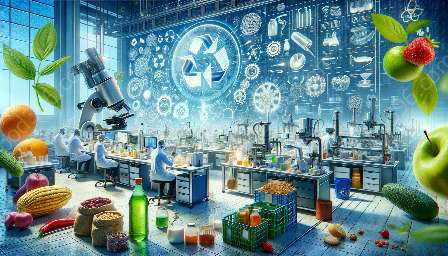Food safety and sanitation are crucial aspects of the food industry, ensuring the production and consumption of safe, high-quality food products. These processes are interlinked with food microbiology and technology, encompassing a range of preventive measures to protect consumers from foodborne illness and maintain hygiene standards throughout the food supply chain.
Understanding Food Safety and Sanitation
Food safety refers to the handling, preparation, and storage of food in ways that prevent foodborne illness. It involves various practices and procedures to ensure the quality and safety of food products. Sanitation, on the other hand, focuses on maintaining cleanliness and hygiene in food production and handling environments to prevent contamination and the spread of pathogens.
These fundamental principles are closely tied to food microbiology, which is the study of microorganisms in food and their impact on its safety, quality, and shelf life. Furthermore, advancements in food science and technology play a significant role in refining food safety and sanitation practices, ranging from the development of innovative processing techniques to the implementation of robust quality control systems.
Role of Food Microbiology
Food microbiology is an integral component of understanding and managing food safety risks. It encompasses the study of microorganisms, such as bacteria, viruses, molds, and yeasts, that can contaminate food and cause spoilage or foodborne diseases. By understanding the behavior and survival of these microorganisms, food scientists and professionals can implement effective control measures to minimize the risk of contamination.
Microbiological testing, including microbial analysis and monitoring, is essential for assessing the safety and quality of food products. By identifying and quantifying microorganisms present in the food processing environment or the final product, potential hazards can be addressed, and appropriate interventions can be applied to prevent microbial growth and ensure consumer safety.
Integration of Food Science and Technology
Advancements in food science and technology have revolutionized the way food safety and sanitation are managed. Modern food processing and preservation techniques, such as pasteurization, sterilization, and cold chain management, have significantly reduced the microbial load in food products, thereby enhancing their safety and shelf life.
Furthermore, the development of food safety management systems, such as Hazard Analysis and Critical Control Points (HACCP), has become instrumental in preventing, eliminating, or reducing food safety hazards throughout the production process. These systems are designed to identify potential biological, chemical, or physical hazards and implement critical control points to mitigate these risks.
Preventing Foodborne Illness
Effective food safety and sanitation practices are vital for preventing foodborne illness, which can result from the consumption of contaminated or improperly handled food. The implementation of strict hygiene and sanitation protocols in food establishments, including restaurants, food processing facilities, and retail outlets, is essential for minimizing the risk of microbial contamination.
Regulatory bodies, such as the Food and Drug Administration (FDA) and the World Health Organization (WHO), play a crucial role in setting and enforcing food safety standards and regulations. Compliance with these standards is mandatory for food businesses to ensure the production of safe and wholesome food products.
Embracing Technological Innovations
The food industry continues to adopt cutting-edge technologies to enhance food safety and sanitation. From advanced packaging solutions that extend shelf life to rapid microbial detection systems that enable real-time monitoring of food processing environments, technology-driven solutions are pivotal in safeguarding the integrity of the food supply chain.
Moreover, the use of data analytics and traceability systems allows for better visibility and control over the entire food production and distribution process, thereby enabling swift identification and containment of any potential food safety risks.
Conclusion
Food safety and sanitation are vital components of the food industry, with direct implications on public health and consumer trust. The synergy between food safety, sanitation, food microbiology, and technology underscores the multifaceted approach required to ensure the safety and integrity of the food supply chain.
By integrating scientific knowledge, innovative technologies, and stringent regulatory frameworks, the food industry strives to uphold the highest standards of food safety and sanitation, ultimately delivering safe and nutritious food products to consumers worldwide.

